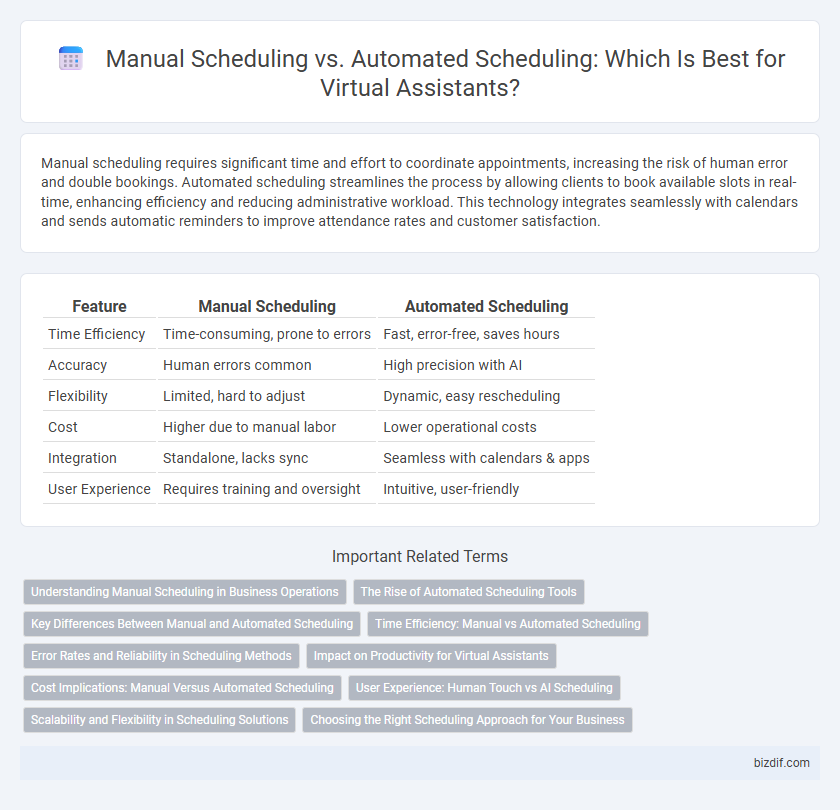Manual scheduling requires significant time and effort to coordinate appointments, increasing the risk of human error and double bookings. Automated scheduling streamlines the process by allowing clients to book available slots in real-time, enhancing efficiency and reducing administrative workload. This technology integrates seamlessly with calendars and sends automatic reminders to improve attendance rates and customer satisfaction.
Table of Comparison
| Feature | Manual Scheduling | Automated Scheduling |
|---|---|---|
| Time Efficiency | Time-consuming, prone to errors | Fast, error-free, saves hours |
| Accuracy | Human errors common | High precision with AI |
| Flexibility | Limited, hard to adjust | Dynamic, easy rescheduling |
| Cost | Higher due to manual labor | Lower operational costs |
| Integration | Standalone, lacks sync | Seamless with calendars & apps |
| User Experience | Requires training and oversight | Intuitive, user-friendly |
Understanding Manual Scheduling in Business Operations
Manual scheduling in business operations involves assigning tasks and appointments through human intervention, using tools like spreadsheets or calendars. This method offers flexibility and personal oversight but often leads to errors, inefficiencies, and time-consuming adjustments. Understanding the limitations of manual scheduling is crucial for businesses aiming to enhance productivity and reduce operational costs.
The Rise of Automated Scheduling Tools
Automated scheduling tools have revolutionized calendar management by leveraging AI and machine learning algorithms to optimize appointment setting with precision and speed. These tools reduce human error, eliminate double bookings, and provide real-time availability updates, significantly enhancing productivity for businesses and individuals alike. Integration with popular platforms like Google Calendar, Microsoft Outlook, and Zoom further streamlines workflow automation, making manual scheduling increasingly obsolete in modern professional environments.
Key Differences Between Manual and Automated Scheduling
Manual scheduling requires human input for task allocation, often leading to increased errors and time consumption. Automated scheduling uses algorithms to optimize time slots and resources, enhancing efficiency and reducing scheduling conflicts. Key differences include accuracy, time management, and adaptability to dynamic changes in calendars.
Time Efficiency: Manual vs Automated Scheduling
Manual scheduling often consumes significant time due to the need for constant human intervention in coordinating appointments and managing conflicts. Automated scheduling streamlines the process by using intelligent algorithms to instantly allocate optimal time slots, reducing scheduling errors and saving valuable hours. Businesses leveraging automated scheduling report up to 75% improvement in time efficiency compared to manual methods.
Error Rates and Reliability in Scheduling Methods
Automated scheduling systems significantly reduce error rates compared to manual scheduling by leveraging algorithms that minimize human input mistakes and conflicts. Reliability in scheduling increases with automation through real-time updates, integration with calendars, and predictive analytics that anticipate potential scheduling conflicts. Manual scheduling tends to suffer from inconsistencies and higher error rates due to human oversight and lack of dynamic adjustment capabilities.
Impact on Productivity for Virtual Assistants
Manual scheduling consumes significant time and increases the risk of errors, reducing overall productivity for virtual assistants. Automated scheduling leverages algorithms to optimize calendar management, minimize conflicts, and save valuable work hours. Implementing automated tools dramatically enhances efficiency, allowing virtual assistants to focus on higher-value tasks and improve service delivery.
Cost Implications: Manual Versus Automated Scheduling
Manual scheduling often incurs higher labor costs due to the time-intensive nature of coordinating appointments and managing calendars, leading to increased overhead for businesses. Automated scheduling systems reduce these expenses by streamlining booking processes through AI-driven tools, minimizing human error and the need for dedicated personnel. Companies investing in automated scheduling report significant cost savings and improved operational efficiency, which enhance overall profitability.
User Experience: Human Touch vs AI Scheduling
Manual scheduling offers a personalized human touch that adapts to nuanced preferences and complex requests, enhancing user satisfaction through empathetic interaction. Automated scheduling leverages AI algorithms to optimize time slots and reduce errors, providing faster and more efficient booking experiences. Balancing manual and AI-driven scheduling systems can improve user experience by combining human insight with technological precision and reliability.
Scalability and Flexibility in Scheduling Solutions
Automated scheduling offers superior scalability by efficiently managing an increasing volume of appointments without compromising accuracy, unlike manual scheduling which becomes cumbersome as demand grows. Flexibility is enhanced in automated systems through real-time updates and seamless integration with multiple calendars, enabling quick adjustments to changing priorities. Manual scheduling often struggles to maintain flexibility and scalability, leading to potential errors and scheduling conflicts during periods of high activity.
Choosing the Right Scheduling Approach for Your Business
Manual scheduling allows businesses to maintain control over appointment details and customize each booking, which benefits industries requiring personalized interactions. Automated scheduling leverages AI technology to increase efficiency, reduce human errors, and enable 24/7 booking capabilities, making it ideal for high-volume environments. Evaluating factors such as team size, customer demand, and the complexity of appointments helps determine whether a manual or automated system best aligns with your operational needs and growth goals.
Manual scheduling vs Automated scheduling Infographic

 bizdif.com
bizdif.com